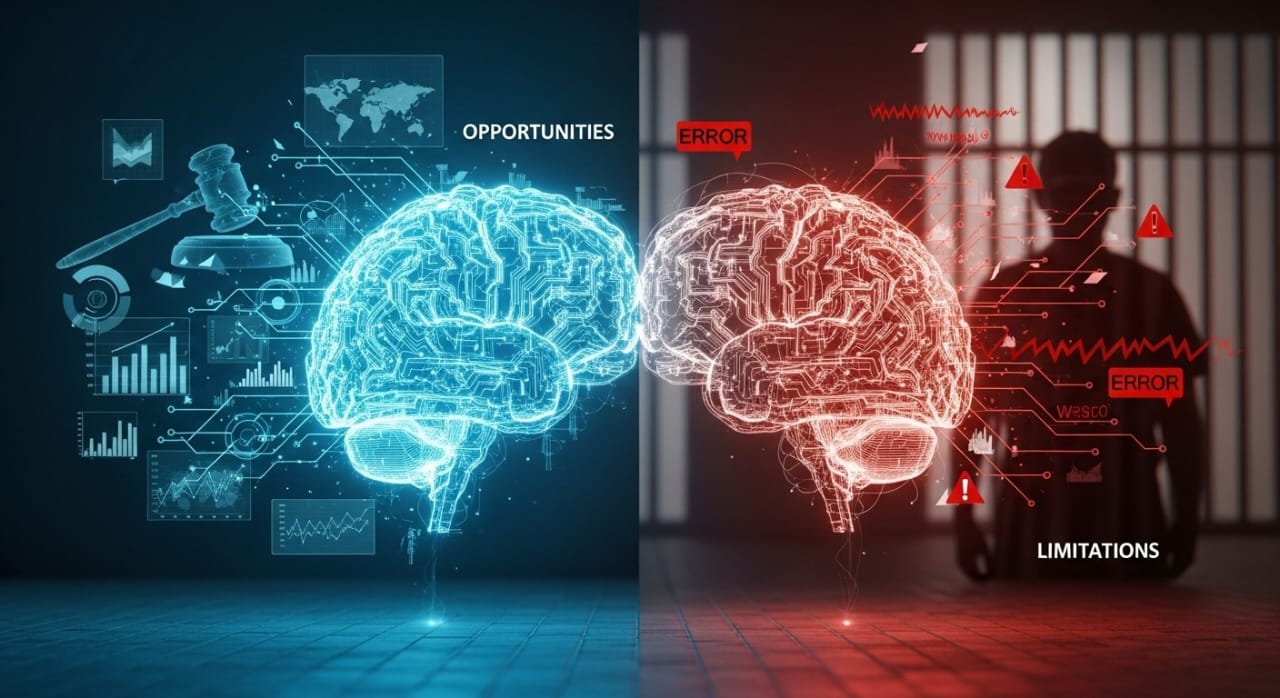- Details

Artificial intelligence is becoming an essential part of the criminal justice system, transforming law enforcement, prosecutions, defense work, and courts. AI applications range from predictive policing and risk assessment to evidence analysis and case management. While these tools expand capacity and accuracy, they raise ethical, legal, and technical challenges unique to criminal law’s high stakes. This blog explores the opportunities and limitations of AI in criminal law, illuminating how AI for legal solutions can be used responsibly to improve outcomes.
Opportunities for AI in Criminal Law
- Enhancing Investigations and Crime Prevention
AI-driven tools assist law enforcement in identifying crime patterns, predicting hotspots, and allocating resources efficiently.
- Predictive policing algorithms analyze historical crime data to forecast where crimes might occur, enabling proactive intervention.
- Facial recognition and biometric analysis aid rapid suspect identification, reducing investigation time.
- AI helps detect cybercrimes by automating threat detection across massive datasets, critical in growing digital crime spaces.
These innovations augment police capabilities while optimizing resource use and public safety.
- Improving Evidence Analysis and Case Preparation
AI supports criminal defense and prosecution teams by enhancing document review, legal research, and case management.
- Machine learning algorithms sift through voluminous records, video footage, and transcripts to extract relevant evidence swiftly.
- Natural Language Processing (NLP) tools help summarize case law, motions, and witness statements, reducing attorney workload.
- Automated risk assessment helps evaluate bail, sentencing, or parole probabilities based on patterns in prior decisions.
These capabilities accelerate workflows and can help improve case accuracy and consistency.
- Supporting Fairer, Data-Driven Decisions
Well-designed legal AI systems can reduce human biases and inconsistencies by providing objective data-driven insights.
- Standardized AI assessments assist judges and parole boards in making evidence-based determinations.
- AI helps flag potential injustices or discrimination by cross-referencing wide data pools.
- Transparency and accountability frameworks around AI deployment build public trust while enhancing procedural fairness.
When responsibly implemented, AI can promote equity and improved access to justice in criminal law.
Limitations and Concerns of AI in Criminal Law
- Privacy and Data Security Risks
Criminal justice AI requires extensive access to sensitive personal data, raising concerns about privacy violations and data breaches.
- Unauthorized access or leaks of biometric, behavioral, and judicial data could have long-term impacts on individuals’ freedoms and reputations.
- Interconnected law enforcement systems create vulnerabilities that must be addressed through robust security measures, transparency, and policy oversight.
Balancing AI efficiency with constitutional privacy safeguards is a critical challenge.
- Bias and Discrimination in AI Models
AI is only as unbiased as the data it learns from. Historical inequities within criminal justice data risk being encoded and amplified by AI systems.
- Risk assessment algorithms may disproportionately label certain demographics as high risk due to biased training data.
- Facial recognition technologies have faced documented accuracy gaps across races and genders.
Regular audits, transparent methodologies, and inclusive data practices are essential to mitigate bias and safeguard fairness.
- Lack of Transparency and Explainability
Complex AI models often operate as “black boxes,” making it hard for lawyers, judges, or defendants to understand or contest AI-driven decisions.
- The opacity of some AI tools complicates constitutional rights to due process and fair trial.
- Effective AI adoption requires explainability frameworks allowing human operators to interpret results and challenge outcomes.
AI systems in criminal law must be accompanied by policies ensuring clarity and legal scrutiny.
- The Essential Role of Human Judgment
AI cannot replace core human functions in the criminal justice system, including empathy, ethical capacity, and advocacy.
- Legal decisions often hinge on subjective narratives, moral reasoning, and contextual nuances beyond AI’s current reach.
- Defense lawyers and judges must remain central to safeguarding rights, evaluating evidence holistically, and deciding sentences.
AI is a tool to augment, not substitute, human expertise and constitutional protections.
Best Practices for Integrating AI in Criminal Law
- Deploy AI systems that meet strict principles of safety, security, fairness, and accountability.
- Maintain transparent data governance policies that respect privacy and constitutional rights.
- Conduct regular independent audits of AI algorithms to detect and correct biases.
- Provide training and support for legal professionals to interpret and responsibly use AI outputs.
- Implement oversight mechanisms ensuring human review and appeal of AI-influenced decisions.
Balanced integration guided by comprehensive ethical frameworks enables AI to enhance trust and legitimacy in criminal justice.
Conclusion
Artificial Intelligence offers promising opportunities to improve criminal justice through greater efficiency, evidentiary support, and data-driven fairness. However, its limitations especially around privacy, bias, transparency, and the irreplaceable role of human judgment require cautious, principled deployment. By focusing on responsible AI use aligned with evolving legal and ethical standards, the criminal justice system can harness ai for legal innovation while protecting individual rights and societal trust. Legal AI’s future in criminal law hinges on balancing technology with human wisdom for a fairer, safer justice system.
